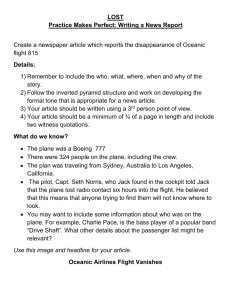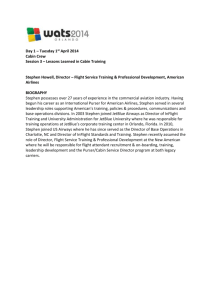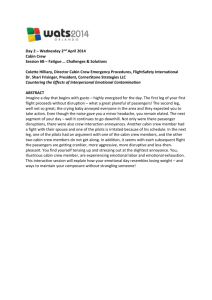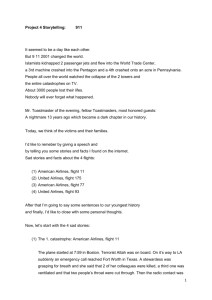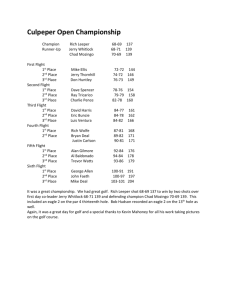Flight Attendant Training: Safety, Security, & Service
advertisement
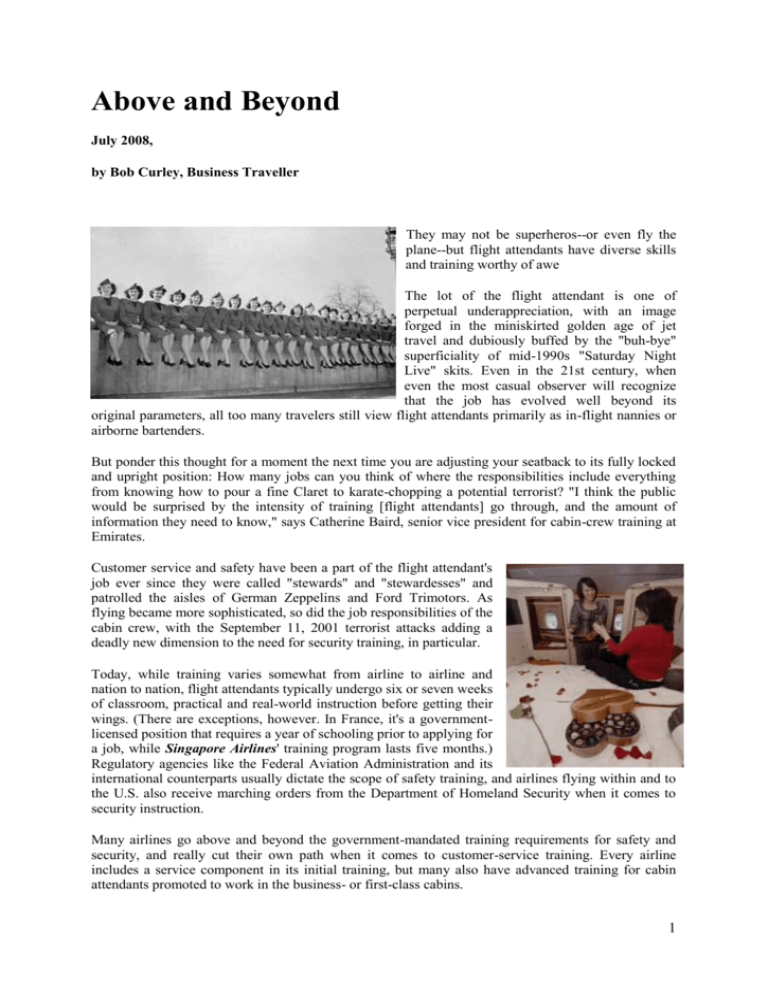
Above and Beyond July 2008, by Bob Curley, Business Traveller They may not be superheros--or even fly the plane--but flight attendants have diverse skills and training worthy of awe The lot of the flight attendant is one of perpetual underappreciation, with an image forged in the miniskirted golden age of jet travel and dubiously buffed by the "buh-bye" superficiality of mid-1990s "Saturday Night Live" skits. Even in the 21st century, when even the most casual observer will recognize that the job has evolved well beyond its original parameters, all too many travelers still view flight attendants primarily as in-flight nannies or airborne bartenders. But ponder this thought for a moment the next time you are adjusting your seatback to its fully locked and upright position: How many jobs can you think of where the responsibilities include everything from knowing how to pour a fine Claret to karate-chopping a potential terrorist? "I think the public would be surprised by the intensity of training [flight attendants] go through, and the amount of information they need to know," says Catherine Baird, senior vice president for cabin-crew training at Emirates. Customer service and safety have been a part of the flight attendant's job ever since they were called "stewards" and "stewardesses" and patrolled the aisles of German Zeppelins and Ford Trimotors. As flying became more sophisticated, so did the job responsibilities of the cabin crew, with the September 11, 2001 terrorist attacks adding a deadly new dimension to the need for security training, in particular. Today, while training varies somewhat from airline to airline and nation to nation, flight attendants typically undergo six or seven weeks of classroom, practical and real-world instruction before getting their wings. (There are exceptions, however. In France, it's a governmentlicensed position that requires a year of schooling prior to applying for a job, while Singapore Airlines' training program lasts five months.) Regulatory agencies like the Federal Aviation Administration and its international counterparts usually dictate the scope of safety training, and airlines flying within and to the U.S. also receive marching orders from the Department of Homeland Security when it comes to security instruction. Many airlines go above and beyond the government-mandated training requirements for safety and security, and really cut their own path when it comes to customer-service training. Every airline includes a service component in its initial training, but many also have advanced training for cabin attendants promoted to work in the business- or first-class cabins. 1 Safety Training Many frequent flyers reduce the standard in-flight safety lecture delivered by flight attendants to background noise, but there's far more behind the routine pantomime about properly affixing a falling oxygen mask and inflating your life vest in the event of a water landing. Emirates, for example, has full-motion simulators at its 236,000-square-foot training center in Dubai to replicate the passenger cabin of its Airbus and Boeing aircraft (including a new, two-story A380 simulator). Here, flight attendants are trained to deal with situations like decompression, turbulence, loss of an aircraft engine, rapid descent and onboard fires. "When you look at the simulator from outside, it's really rocking and rolling," says Baird. Like a cockpit simulator, the cabin simulators also replicate various outside environments, from a night sky to fire during emergency evacuation drills. At most airlines, role-playing is a critical part of training, with prospective flight attendants playing the parts of disabled passengers, mothers with children and other passengers. The ability to swim is part of the job requirements for cabin crew, and airlines use pools to train flight attendants on how to evacuate an aircraft during a water landing and how to inflate and board emergency life rafts. Flight attendants also are trained to size up passengers as they board each flight. "When you get on the aircraft, you have a flight attendant there greeting you, but they also are looking at you to determine what kind of person you are, whether you are an able-bodied person who could help in an emergency," says Trevor Slade, manager of service training for Etihad Airways. Slade began his career in the airline industry as a cabin-crew member for Monarch Airlines, then moved to British Airways, where he became an instructor in 1987. U.S. carriers like American Airlines are required by law to train cabin crew to accommodate passengers with disabilities, but international carriers also conduct this type of training; Asiana Airlines, for example, teaches its flight attendants how to accommodate vision-impaired passengers, as well as other individuals with disabilities. An impressive amount of health-related training also is delivered, from basic first aid to CPR, the Heimlich maneuver, how to administer anti-seizure drugs to epileptics and the use of onboard defibrillators. "If someone collapses in the aisle, it's not the same as if you were on the ground," notes Emirates' Baird. "There are other passengers around, and you have to perform CPR in the confines of an aircraft." Flight attendants are taught how to assist someone giving birth, and what to do if a passenger dies onboard. Emirates flight attendants are trained to use the Tempus satellite-communication system to talk to a ground-based physician in the event of a medical emergency, and to recognize the symptoms of stress and how to calm nervous passengers—with anti-anxiety medication, if necessary. Some airlines also teach flight attendants about the basics of aeronautics, including the normal sights and sounds of flaps, landing gear, and other aircraft components—knowledge that comes in handy not only when dealing with fear of flying, but also in identifying when something actually goes wrong with the aircraft. "That happens over time and comes with experience," says Slade. Security Flight attendants have always had primary responsibility for maintaining security in the aircraft cabin, but the terrorist hijackings of the 1970s and 1980s, and especially the September 11, 2001 attacks in the U.S., have lent a deadly seriousness to this aspect of flight-attendant training. 2 Flight attendants need to know how to deal with a wide range of situations that can lead to dangerous or violent situations onboard aircraft, stemming from alcohol abuse, anger over flight delays, domestic disputes or other causes. Security training is especially valuable to long-haul carriers. "On a 14-hour flight, there's a lot more time for things to happen," notes Baird. "In security training, we work on advanced restraint techniques to manage disruptive people," Baird explains. "It's not martial arts, per se, but we use some of the principles." "Since 9/11, there's been a lot of change on the security side, a lot more hands-on training than lecture," adds Marie Whitworth, manager of curriculum development for flightattendant training at American Airlines. While airlines are loathe to provide details about security training—even other employees are barred from observing this portion of flight-attendant instruction at American's Dallas training facility, for instance, behavioral analysis is a key component, said Whitworth. "There's a lot more awareness of the passenger coming onboard, looking for unusual behavior and how to react," she says. Fast reactions by flight attendants, for example, helped thwart "shoe bomber" Richard Reid's attempt to blow up an American Airlines flight from Paris to Miami in December 2001. Customer Service If you want to learn about Air France's latest quarterly earnings or the best way to navigate the airline's hub at Charles de Gaulle International Airport in Paris, just ask a flight attendant in the premium cabin. Air France's advanced training includes a three-day general overview of the airline and its operations, including everything from marketing and the economics of the airline industry to maintenance, airport information and details on Air France's participation in the SkyTeam alliance. "When you are on a 12-hour flight in first class, customers don't only want to talk about food and beverage," says Catherine Betsch, flight attendant vice president at Air France. "It is very important that our flight attendants have a very wide knowledge of the company." That's just one example of the varying approaches that airlines take in customer-service training for flight attendants. For most airlines, customer service begins with selecting the right types of people to become cabin crew. Emirates, for example, accepts only 4,000 of the 74,000 applicants—the top five percent—to become flight attendants, while Air France subjects jobseekers to a rigorous psychological review. Ideal candidates include those who are comfortable working with others, at night and away from home, notes Betsch. "Before, when it was not so common to take the plane, flight attendants were like models," she adds. "Now, because we need more friendly relationships with the customers, we're not looking for models, but for people who are friendly, open and generous." As part of its Brilliant Basics, Magic Touches program, Virgin Atlantic gives cabin crew two weeks of customer-service training, including diversity, cultural and religious understanding. That's typical of international carriers, which not only deal with passengers from many cultures, but also employ multicultural cabin staff. 3 Emirates, for example, spends a good deal of time focusing on Arab culture and Islamic customs and mores, including taking trainees to a mosque and teaching them how to serve the traditional Arabic meal of coffee and dates. Flight attendants are taught how to serve veiled Muslim women ("Talk to the male they are with first," advises Baird), and to recognize and respect different cultural traditions. For example, says Etihad's Slade, "'Please' and 'Thank you' are accepted in the West, but in a lot of cultures, it doesn't necessarily exist. It doesn't mean the passenger is being rude. What may be acceptable to you may not be for someone else." In Asia, symbolic acts of deference are common and expected. "Flight attendants are taught to kneel to address passengers at their level, not look down on them," says Joel Chusid, general manager of North America at Hainan Airlines. "At the beginning of a flight, our flight attendants are introduced to passengers and bow as a sign of respect." Being on the receiving end of a bow remains a bit discomfiting for most Americans, however, so Hainan is providing special training to its flight attendants as the Chinese airline prepares to enter the U.S. market. "We've just completed cross-cultural training by an American company where cultural differences and etiquette were explored," says Chusid. "This got down to even such details as [at] what temperatures Americans expect their food and beverages, and how they like to be addressed." Airlines that hire staff from around the world—Emirates has 117 nationalities on the payroll—garner special benefits from the practice in training. "You don't have to rely on a PowerPoint presentation when you have someone sitting next to you from Korea who can talk to you about their culture," notes Emirates' Baird. Some flight attendants come from cultures that better lend themselves to a service enviroment. Japan's All Nippon Airways (ANA) uses the slogan Anshin, Attaka, Akaruku Genki—Warm, Reliable and Friendly—as the basis for its flight-attendant training program. "The culture of Japan relies so heavily on respect and hospitality, so these ideals have been established in our cabin attendants since well before they put on the uniform," notes airline spokesperson Damion R. Martin. "In Asia, service is a profession that is studied and practiced," agrees James Boyd, a spokesperson for Singapore Airlines. "In the West, it's something you do until you do what you really want to do." Lufthansa, on the other hand, puts a special emphasis on "emotionalization"—creating a customer-centered focus among cabin crew whose cultural background typically favors efficiency over warmth, says Anne-Marie Duwe, head of cabin-service training for Lufthansa. Korean Air runs a special Smile Academy to help flight attendants overcome some of their own cultural limitations. "Flight attendants learn direct eye-contact and how to extend a broad smile, characteristics not found in Korean culture," says Penny Pfaelzer, an airline spokesperson. "While our attendants are always sensitive and respectful by nature, they learn during their training how to become more welcoming and attentive." Asiana Airlines takes a similar approach in its service training. The airline "emphasizes that flight attendants 4 should be able to read foreign customers' minds through eye-contact," says Chayoun Lee, a spokesperson for Asiana. "Eye- contact is the basis of communication; many thoughts can be expressed by the eye." Asiana and ANA also enhance their service by working together, swapping some flight attendants on codeshared flights to ensure that passengers can communicate with cabin crew in their own language, notes AN A's Martin. Customer-service training for cabin crew ranges from the mundane— American educates flight attendants in basic sales techniques and may soon begin selling duty-free type products during domestic flights—to the esoteric, such as wine appreciation. Virgin Atlantic, for example, is the only airline accredited to deliver the Wine & Spirit Education Trust's Foundation Certificate in Wines. "Cabin crew have the chance to come in and complete this day-long, nationally recognized qualification," says Laura Kilroy, a spokesperson for Virgin Atlantic. "The day starts with a thorough introduction to the world of wines, and we look at factors that influence flavor and taste; in the afternoon, we taste six different wines from around the world, and spend some time looking at food and wine matching." Cabin crew have to pass an exam to receive their certificate. Airlines based in Muslim countries also include wine appreciation and alcohol service in their foodand-beverage training, although this sometimes includes special challenges. "We have a lot of crew who don't know what a gin and tonic is," points out Emirates' Baird, who has implemented an elearning course that utilizes the knowledge of another company in the Emirates Group: a wine distributor. Emirates' training facility includes a full flight kitchen where cabin crew can learn the art of preparing and serving food and drinks, including the art of silver service and plating food. An equally important art—how to maneuver the food and beverage cart—is practiced in cabin mockups. "It's important to get speed of service as well as politeness," stresses Etihad's Slade. "You're not doing dining on demand for 300 people, but you still can make certain that you're treating people as individuals." Asiana's remarkable training facilities in Seoul also include a number of specialized facilities for service and safety training, including a wine room, makeup room and a Walking Room. "Our flight attendants practice walking in the Walking Room, which looks like a ballet studio," says Lee. "This will allow them to walk more safely and elegantly in the aisle." Drawing upon the airline's customer information database, Asiana flight attendants receive a pre-flight briefing about VIPs boarding each flight, including all first-class passengers. In addition to basics like food and drink preferences, "Flight attendants already have information on what our passengers' habits are, such as not being disturbed after a meal and when to be woken up before landing and whether they want coffee right after they sleep," said Steve Koo, Asiana's senior manager of marketing and alliances for the Americas. 5 When encountering first-time customers, Asiana cabin crew are trained to gently probe for preference information, including how VIP travelers prefer to be addressed. "Once we store the information, they will be recognized and be called as they wish," said Koo. Business-class and first-class passengers are the primary beneficiaries of airlines' advanced service training. Emirates and Etihad, for example, take their hospitality training cues from hotels, not other airlines: Etihad even recruits hotel food-and-beverage staff as cabin crew. "We try to ensure that service is very much about the in dividual: Businessclass passengers should feel like they are in a private club; first-class passengers should feel like they are in a private aircraft," says Slade. "We teach our cabin crew to get all of the passenger's information at one take, so they don't have to keep going back . . . We want them to get what they want when they want it, not to be bothered, but still feel the cabin crew is responsive to their needs." Unlike most U.S. airlines—where promotions to international flights and premium cabins are based on seniority under union rules—airlines like Emirates and Etihad use a merit-based system to select flight attendants to receive advanced training to serve their most valuable customers. "There are a lot of cultures where being a member of the cabin crew is still seen as a very prestigious job, so we can employ people who look at flying as special," said Slade. "Etihad doesn't have 50 years of history and doesn't have people who have been working here 30 years and don't enjoy the job. Legacy airlines have people who have been working there for a long time, but not necessarily for the right reasons." "When I served as cabin crew, there wasn't as much emphasis on guests," adds Slade. "There was a focus on customer service, but not at the level you see now. That's where airlines can make a difference; the differentiation is the quality of the cabin crew and service on the aircraft." 6


